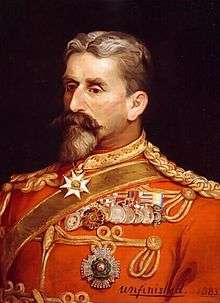Charles MacGregor
| Sir Charles MacGregor KCB CSI CIE | |
|---|---|
 | |
| Born |
12 August 1840 Agra, India |
| Died | 5 February 1887 (aged 46) |
| Allegiance |
|
| Service/branch |
|
| Rank | Major-General |
| Battles/wars |
Lucknow; Battle of Magdala; Battle of Kandahar |
| Spouse(s) |
Frances Mary Durand; Charlotte Mary Jardine |
Major-General Sir Charles Metcalfe MacGregor KCB CSI CIE (12 August 12, 1840 – 5 February 1887) was an Anglo-Indian explorer, geographer and officer of the British Indian Army. He was the Quartermaster General for the British Army in India, the head of the Intelligence Department for the British Indian Army and served under Frederick Roberts in the Second Anglo-Afghan War. The MacGregor Medal is awarded in his honour.
Biography
Of Scottish descent, MacGregor was born in Agra, India, the son of Major Robert Guthrie MacGregor of the Bengal Artillery. His grandfather was Major-General James MacGregor of the Bengal Cavalry.[1] MacGregor was schooled at Marlborough College before returning to India aged 16 to join the Bengal Army.[1] Arriving just in time for the Indian Rebellion of 1857, MacGregor fought in a number of actions, including at Lucknow and was wounded twice.[1]
MacGregor earned successive promotions whilst serving variously in campaigns in China, the Bhutan War (where he became the deputy assistant Quartermaster General) and Abyssinia including at the Battle of Magdala. In the Second Afghan War MacGregor served as Quartermaster General on the Khyber communication lines and commanded the 3rd Brigade of the Kabul-Kandahar field force at the Battle of Kandahar.[2] In the second phase of the Second Afghan War he became Commander Stewart's and Earl Roberts' chief of staff.[2] After the Second Afghan War, training of men in intelligence gathering became the responsibility of the Quartermaster General and MacGregor served in this role for the East Indies until 1885.[3]
In 1870, MacGregor founded the United Service Institution of India for the "furtherance of interest and knowledge in the art, science and literature of the Defence Services."[4] The Institution awards the MacGregor Medal, founded in his memory, in recognition of valuable contributions to military intelligence that are of defensive importance to India.[5]
MacGregor's The Defence of India (1884) attempted to alert the British public to the geo-strategic importance of India, and the threat posed to British interests by Russia.[6]
MacGregor was decorated variously with the Order of the Bath (Knights Commander), the Order of the Star of India (Companion) and the Order of the Indian Empire (Companion).[7] He was promoted to Major General weeks before his death on 5 February 1887.[7][8]
Family
In 1869, he married Frances Mary, daughter of Sir Henry Marion Durand; she died on 9 May 1873; they had one daughter. In February 1883, he married Charlotte Mary Jardine.[3]
Works
- Narrative of a journey through the province of Khorassan and on the n.w. frontier of Afghanistan in 1875, 1879
- Wanderings in Balochistan, 1882
- The defence of India: a strategical study, 1884
See also
References
- 1 2 3 Holdich, T.H. Obituary: Sir Charles M. MacGregor, Proceedings of the Royal Geographical Society and Monthly Record of Geography, Vol. 9, No. 3 (Mar, 1887), pp. 194-196
- 1 2 Laurie, W.F.B. Sketches of Some Distinguished Anglo-indians (W.H. Allen & Co. 1888)
- 1 2
 Oliver, Samuel Pasfield (1893). "MacGregor, Charles Metcalfe". In Lee, Sidney. Dictionary of National Biography. 35. London: Smith, Elder & Co.
Oliver, Samuel Pasfield (1893). "MacGregor, Charles Metcalfe". In Lee, Sidney. Dictionary of National Biography. 35. London: Smith, Elder & Co. - ↑ "History of the United Service Institution of India".
- ↑ "The MacGregor Medal". Archived from the original on 2008-05-11.
- ↑ Adrian Preston, Sir Charles MacGregor and the Defence of India, 1857-1887, The Historical Journal, XII, 1 (1969), pp. 58-77
- 1 2 The London Gazette: no. 25674. p. 848. 18 February 1887. Retrieved 2 July 2015.
- ↑
 Oliver, Samuel Pasfield (1893). "MacGregor, Charles Metcalfe". In Lee, Sidney. Dictionary of National Biography. 35. London: Smith, Elder & Co.
Oliver, Samuel Pasfield (1893). "MacGregor, Charles Metcalfe". In Lee, Sidney. Dictionary of National Biography. 35. London: Smith, Elder & Co.